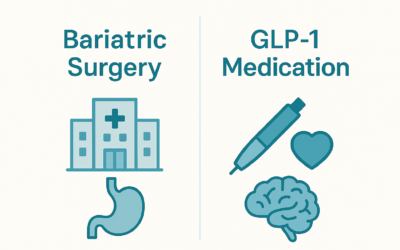If you’ve been looking into weight loss medications, you’ve probably come across GLP-1 receptor agonists like semaglutide (Wegovy, Ozempic) or tirzepatide (Mounjaro). These medications have become some of the most talked-about tools for weight loss and diabetes management — and for good reason. They deliver results, helping people lose significant amounts of weight while improving their metabolic health in ways that diet and exercise alone often can’t.
But, like any medication, GLP-1 receptor agonists aren’t without side effects. Understanding what to expect — and how to manage those side effects — can help you make an informed decision and prepare for a smoother experience. Here’s a closer look at GLP-1 side effects and what you should know before getting started.
What are GLP-1 receptor agonists, and how do they work?
Before we dive into the side effects, let’s take a moment to understand how GLP-1 medications work. GLP-1 receptor agonists mimic a hormone your body already produces: glucagon-like peptide-1 or GLP-1. This hormone plays a critical role in regulating your blood sugar, your appetite, and your digestion. When you take a GLP-1 medication, it activates receptors in your body that:
- Slow digestion: By delaying how quickly food leaves your stomach, these medications help you feel full longer after eating. This can significantly reduce hunger and calorie intake.
- Regulate blood sugar: By increasing insulin production and slowing the release of glucose into your bloodstream, GLP-1 medications help keep your blood sugar levels stable.
- Suppress appetite: They signal your brain to reduce cravings, and they make sticking to a lower-calorie diet feel more manageable.
What sets these medications apart from older, less effective weight loss drugs is how they combine appetite suppression with metabolic regulation. They don’t just help you eat less — they improve how your body processes food and stabilizes energy levels, making them uniquely effective both for weight loss and for managing type 2 diabetes, which often goes hand-in-hand with carrying a lot of extra weight.
For many people, these benefits outweigh the temporary side effects that may come along with these medications. But understanding how your body might react is important to having a positive experience with GLP-1 medications.
Common GLP-1 side effects
Most people experience mild to moderate side effects when starting GLP-1 medications. The good news? These side effects are usually temporary and generally improve as your body adjusts to the treatment. Here’s what you’re most likely to encounter:
Nausea
Nausea is the most common side effect and happens because the medication slows down how quickly your stomach empties. While this helps with appetite control, it can leave you feeling overly full or queasy—especially if you eat larger meals or rich foods.
How to manage it:
- Start with a lower dose and increase gradually, as prescribed by your doctor. This step alone can make a big difference in reducing nausea.
- Eat smaller, more frequent meals instead of large portions, and avoid skipping meals.
- Steer clear of greasy, spicy, or fried foods, which can aggravate nausea. Instead, focus on light, easy-to-digest meals.
- Ginger tea or ginger chews can also help settle your stomach naturally.
It’s worth noting that for most people, nausea tends to ease up after the first few weeks as their body adjusts.
Vomiting
For some, nausea may escalate to vomiting, especially during the early weeks. This can happen if you eat too much too quickly or if your body struggles to adapt to the slower digestion. While less common than nausea, it can be disruptive if it happens frequently.
How to manage it:
- Stay hydrated to prevent dehydration if vomiting occurs. Take small sips of water or electrolyte drinks throughout the day.
- Avoid lying down immediately after eating, as this can worsen nausea and increase the likelihood of vomiting.
- If vomiting persists, speak with your care coach or your provider. They may adjust your dosage or prescribe anti-nausea medication to help manage the symptoms.
Diarrhea or constipation
GLP-1 medications can disrupt your normal digestion, leading to changes in bowel habits. Some people experience diarrhea, while others may deal with constipation. Both can usually be managed with small adjustments to your diet and routine.
How to manage it:
- For constipation: Increase your water intake and focus on fiber-rich foods like fruits, vegetables, and whole grains. Gentle exercise, like walking, can also help stimulate digestion.
- For diarrhea: Stick to bland, easy-to-digest foods like bananas, rice, and toast, and avoid high-fat or heavily spiced meals that might irritate your stomach further.
If either condition becomes severe or persistent, consult your care coach or your provider for additional strategies or medications.
Bloating and gas
Bloating and increased gas can also happen as your digestion slows down. While this side effect is usually mild, it can be uncomfortable—especially if you’re not used to feeling “full” for extended periods.
How to manage it:
- Eat slowly and chew your food thoroughly to minimize swallowing excess air.
- Limit carbonated beverages, as the bubbles can contribute to bloating.
- If bloating persists, try peppermint tea or a light digestive enzyme supplement to ease discomfort.
Adjusting your eating habits and being mindful of your food choices can go a long way in managing these symptoms.
Rare but serious GLP-1 side effects
While most side effects are mild, there are some rare but more serious risks to keep in mind. These aren’t common, but it’s important to know what to watch for.
Pancreatitis
GLP-1 receptor agonists have been linked to pancreatitis (inflammation of the pancreas) in rare cases. Symptoms include severe abdominal pain that radiates to your back, nausea, vomiting, and fever.
What to do:
If you experience symptoms of pancreatitis, stop taking the medication and contact your provider immediately. Pancreatitis is a serious condition that requires prompt medical attention.
Gallbladder issues
Gallstones can sometimes show up during rapid weight loss, and it’s not the GLP-1 medications themselves that are to blame — it’s the speed of the weight loss itself. When you lose weight quickly, your liver releases extra cholesterol into bile, and your gallbladder may not empty as effectively. This combination can increase the likelihood of gallstones forming.
What to do:
If you notice symptoms like sharp pain in your upper-right abdomen, nausea, or yellowing of your skin, don’t ignore them. Reach out to your provider to discuss next steps. They may recommend adjustments to your weight loss plan or medications to support bile flow and reduce the risk of gallstones.
Kidney problems
Severe dehydration from vomiting or diarrhea can strain your kidneys, especially if you already have kidney issues. Signs to watch for include dark urine, dizziness, or extreme thirst.
What to do:
Stay hydrated, and contact your provider if you notice persistent symptoms of dehydration. Your provider may recommend IV fluids or other treatments to support your recovery.
Are GLP-1 side effects worth the results?
The side effects of GLP-1 receptor agonists can sound intimidating, but for most people, the benefits far outweigh the challenges. These medications don’t just help you lose weight — they also address underlying metabolic issues, such as insulin resistance, that can make weight loss feel impossible. By improving how your body processes food and regulates blood sugar, GLP-1 medications set you up for long-term success.
And when it comes to weight loss, the results speak for themselves. Studies show that people using GLP-1 medications lose significantly more weight than those relying on diet and exercise alone. The key is knowing how to manage the adjustment period. Most side effects are temporary and manageable, especially with the right strategies and support.
Tips for success when starting GLP-1 medications
Here are some strategies to help you ease into treatment and stay on track:
- Start low and go slow: Gradually increasing your dose, as prescribed, can help minimize side effects like nausea and bloating.
- Stay hydrated: Keep a water bottle handy and aim to drink throughout the day to support digestion and prevent dehydration.
- Plan your meals: Focus on smaller, nutrient-dense meals that are easy to digest. Avoid skipping meals, as this can worsen nausea.
- Be patient with your body: Side effects often subside as your body adjusts, but don’t hesitate to reach out to your care coach or your provider if symptoms persist.
Taking these steps can make your transition onto GLP-1 medications smoother and help you stay focused on your long-term goals.
The bottom line
GLP-1 receptor agonists are powerful tools for weight loss and improving overall health, but they aren’t without challenges. Side effects like nausea, bloating, and digestive changes are common at first, but they’re usually temporary and manageable. For most people, the significant weight loss and metabolic improvements far outweigh the early hurdles.
By understanding what to expect and working with your care coach and your provider, you can make the adjustment smoother and stay focused on your long-term goals. GLP-1 medications aren’t just about helping you lose weight — they’re about transforming how your body works, so you can feel and live better, too.



